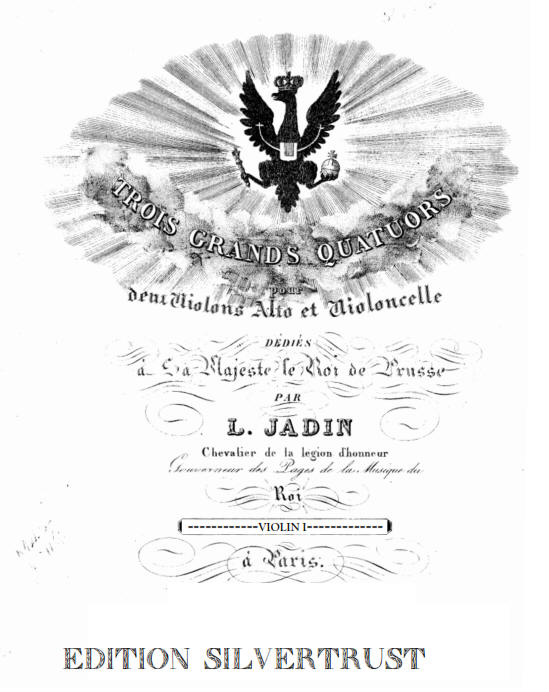Presents
Louis-Emmanuel Jadin
String Quartet No.1 in E flat Major
 Louis-Emmanuel
Jadin ( 1768-1853) was born at Versailles where his father was a violinist at
the Chapelle Royale. Jadin was taught the violin by his father and served as a
page at the court of Louis XVI. Between 1796 and 1816, he taught at the Paris
Conservatory. By 1820 he had retired (though he lived for another 33 years)
and for the most part stopped composing. During the last decade of the 18th and
first two decades of the 19th century, he was one of France's leading musicians,
highly regarded as a violinist, pianist and as an composer. Jadin wrote a
considerable amount of music including 40 operas and operettas, 4 piano
concertos, sinfonie concertantes, works for wind band, string quartets, piano
music, masses, and songs. the fact that he wrote string quartets, in and of
itself, sets him apart from most of his French contemporaries who, much like the
French musical public, were not, at the time, very interested in chamber music.
Louis-Emmanuel
Jadin ( 1768-1853) was born at Versailles where his father was a violinist at
the Chapelle Royale. Jadin was taught the violin by his father and served as a
page at the court of Louis XVI. Between 1796 and 1816, he taught at the Paris
Conservatory. By 1820 he had retired (though he lived for another 33 years)
and for the most part stopped composing. During the last decade of the 18th and
first two decades of the 19th century, he was one of France's leading musicians,
highly regarded as a violinist, pianist and as an composer. Jadin wrote a
considerable amount of music including 40 operas and operettas, 4 piano
concertos, sinfonie concertantes, works for wind band, string quartets, piano
music, masses, and songs. the fact that he wrote string quartets, in and of
itself, sets him apart from most of his French contemporaries who, much like the
French musical public, were not, at the time, very interested in chamber music.
String Quartet No.1 was composed around 1800 though not published for more than a decade. It was the first of a series of three dedicated to the King of Prussia. In this quartet, it is clear that while Jadin had advanced considerably beyond the kind of melodic writing of the Mannheim School, he had not yet assimilated the harmonic changes pioneered by Haydn and Mozart. Hence, for the most part, the first violin has all of the thematic material, while the other voices provide an accompaniment. Despite this, it is a quartet of historic significance because it is an exemplar of the kind of chamber music which was popular during France's revolutionary and Napoleonic period. In it, we find the older 18th century style combined with the more dramatic melodic writing of the early romantic period.
The first movement, Allegro non troppo, is an excellent example of this synthesis, with its lovely melodies but still structurally wedded to the older structural format. The second movement, Adagio, sports a noble main theme which could easily serve as slow processional for royal or imperial occasions. The Allegretto menuetto which follows is interesting in the long-lined lovely lyrical theme has a strong, march-like pounding quarter note accompaniment in the other voices. The trio section makes a nice contrast. The finale, Allegro non troppo, in 6/8 could easily serve as equine romp across the countryside, however the non troppo tempo creates an interesting effect that does not convey this. But later it is interrupted by a much quicker section which conveys a chase-like mood.
Originally published in 1814, there have been no subsequent editions. Our edition is a very clean reprint of the original. Nonetheless, readers should be aware that editions printed before 1850 are not quite as readable as modern edition, however, our reprint is a performance edition with proper page turns and quite readable.
Parts: $24.95